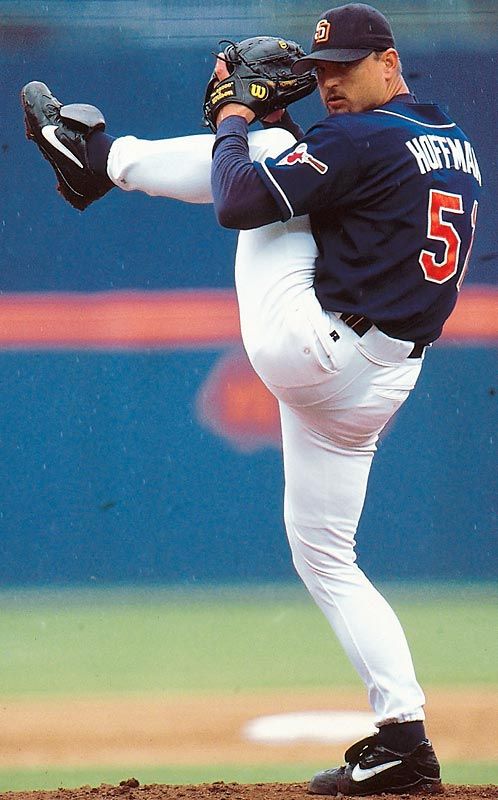With Mike Piazza’s recent election into the National Baseball Hall of Fame, I’m certain that everyone who loves Padres baseball got a little excited on some level, due to one of “our” guys getting in. I got to thinking that it’d be fun to do a post dedicated to former Padres enshrined in Cooperstown. On top of that, I decided to have some fun with it and add managers, coaches, broadcast members and PCL Padres as well.
I’d assume that in the next year or two, I’ll be adding Trevor Hoffman to this list; but outside of Hoffman, there are others who’ve represented the Padres that can still potentially get in one day. Names such as Steve Garvey, Fred McGriff, Gary Sheffield, Bruce Bochy, Minnie Minoso, Lefty O’Doul, Ted Leitner and even possibly Alan Trammell or Mark McGwire all deserve consideration. Yes, some of these guys may be long shots, but still, based solely on their San Diego connection, I’ll always be excited that at least some of our guys are in the discussion for baseball immortality.
(NOTE: THIS POST WILL BE UPDATED TO REFLECT NEW HOF MEMBERS)
Roberto Alomar

Alomar was the Padres second basemen from 1988-1990 and was elected into the Hall of Fame in 2011. While he only spent his first 3 seasons in the big leagues with San Diego, those years were solid, as he earned Rookie of the Year votes and was also an All-Star. After being traded to the Blue Jays after the 1990 season, I always followed his career and in my opinion, he was the best defensive second basemen of my lifetime. In fact, he may be responsible for me wanting to learn how to play the infield, after growing up playing outfield for the most part.
As much as I loved the Alomar due to the Padres connection, it was always bittersweet to watch him, due to the fact that he was flipped during the Padres fire sale of 1992 & 1993. I’ll always remember my dad telling me to keep an eye on both Roberto and Sandy Alomar. I’ll also always remember my dad’s disdain for Padres ownership during this time; specifically Tom Werner. It’s not an exaggeration to say that he’s still mad about what Werner and that ownership group did to the team. (Image Source: BaseballHall.Org)
Sparky Anderson

I’m not sure if it’s still like this, but during my childhood, collecting baseball cards went hand in hand with being a baseball fan. As far as my circle of friends were concerned, you could not just play or watch baseball, you HAD to collect cards as well. If not, you were missing a key component of what it was all about. If you didn’t take part in collecting and trading cards, you were going to be left out of a LOT. You may be curious as to why I bring this up? Well, because when I first discovered baseball, outside of players on the Padres and A’s, there were a handful of individuals in the game that fascinated me for some reason or another and based on his 1987 and 1988 Topps baseball cards, Sparky Anderson was one of these people.
I was mesmerized by the white-haired manager of the Tigers. He looked as if he had an aura of baseball wisdom surrounding him and I remember looking at his cards and thinking “THIS is what a manager is supposed to look like!” Years later, I discovered that Sparky was the third base coach for the inaugural 1969 San Diego Padres, which is obviously cool, but what I thought was really cool is that he pretty much looked exactly the same in 1969, as he did in the late 1980s. Honestly, if you watch his Hall of Fame induction in 2000, you can make the claim that he stopped aging in the late 1960s.
Jerry Coleman
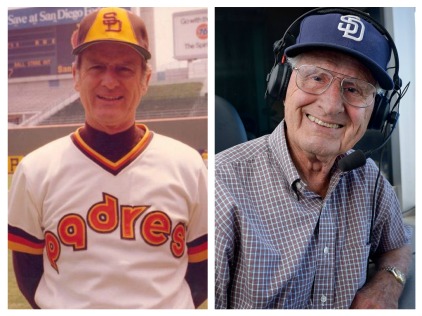
The Colonel became the voice of the Padres in 1972, and with the exception of his stint as the Padre manager in 1980, he never left the booth. Yes, as he aged, his workload became lighter, but that doesn’t mean he wasn’t relevant or contributing. In fact, I loved him even more, as it made his segments and the games he actually did work even that more special. In 2005, he was awarded the Ford C. Frick Award and while that may not make him a “Hall of Famer” by definition, he’s still immortalized for eternity in Cooperstown. While I surely have countless Jerry memories that I could express here, I’ll pull this excerpt from my post on 90 Feet of Perfection, entitled “Goodbye, Jerry Coleman.”
I associate Jerry Coleman with my love of the game. I’ve watched and listened to Padres games since I was a kid and Jerry Coleman has always been the one constant in that organization through my entire life. Along with Tony Gwynn, there’s not a person involved in the game of Baseball that’s meant as much to my family and myself and that’s the honest truth. I’ll always associate family with Jerry Coleman and to this day, my dad still quotes Jerry’s trademark “Oh Doctor, You can hang a star on that baby!” If I ever have children, I know that I’ll continue this tradition and while telling them of great (and not so great) Padres of the past, much like my parents and Grandmother did with me. Rest assured, Jerry Coleman will be at the top of that list.
In ways, Jerry Coleman was the heart and soul of the San Diego Padres and still continues to be. The Colonel is a Hall of Famer on so many levels and I hope this is not lost on future generations of both Padres fans and baseball fans in general.
Larry Doby

The man who integrated the American League played for the PCL Padres for a short period of time in 1959. In the twilight of his career, with his baseball skills deteriorating, Doby bounced around a number of teams. During this period of time, the Indians decided to take another chance on their former slugger and reacquired him from the White Sox. Cleveland optioned Doby to the Padres; their AAA affiliate at the time. Unfortunately, Doby only played 9 games with the Padres, due to breaking his ankle in a game against the Sacramento Solons. The injury was essentially the nail in the coffin of Doby’s playing career.
In 1998, almost 40 years after his last game as a player in the big leagues, Doby was elected by the Veteran’s Committee to the National Baseball Hall of Fame. I could be wrong, but I don’t think I’ve ever seen a photo of Larry Doby from his time in San Diego. If anyone ever finds one, let me know and I will update this photo.
Bobby Doerr

Bobby Doerr will forever be known as a member of the Red Sox, and rightfully so. He spent his entire major league playing career as the second basemen of the Red Sox, later becoming a scout, instructor and then first base coach for the team. Hell, his #1 uniform number is retired with the team and he’s (obviously) wearing a Red Sox cap on his Hall of Fame plaque, where he was inducted in 1986. In fact, with the exception of being the Blue Jays hitting coach from 1977 to 1981, and his years in the Pacific Coast League prior to the big leagues, he’s never not been affiliated with the Red Sox.
Doerr broke into professional baseball at the age of 16 with the Hollywood Stars of the Pacific Coast League. He spent his first two seasons in Hollywood and when owner, Bill Lane decided to relocate the team to San Diego and re-brand them as the Padres, Bobby Doerr came to town as the team’s 18-year-old second basemen. In his first and only year with the Padres, he hit .342, with 238 hits over 175 games. Doerr joined the Red Sox the following season and the rest was history. If you watch the documentary, “The First Padres,” there’s some great interview footage with him regarding his time with the Padres and as a teammate of Ted Williams. It’s easily my favorite part of the film.
Dick Enberg

In 2010, Dick Enberg took over as the Padres play-by-play broadcaster and the sportscasting legend quickly dove into the world of San Diego Padres baseball. To anyone listening to Dick, it’s apparent that he’s both passionate and well versed regarding San Diego sports. It was no surprise to anyone that his years in the Padres booth, on top of his years in the Angels booth (1969 to 1981) lead to him being awarded the 2015 Ford C. Frick Award.
I think I speak for all Padres fans when I say that Enberg’s time in San Diego has been frustrating at times, as he often shows his age, which leads to him making incorrect calls. However, in the end, I think we all adore him. Honestly, I think some fans (including myself) were initially resistant to him, solely based on the irrational fact that his name isn’t Matt Vasgersian, the fan favorite that he essentially replaced in the booth. Still, with that said, I love seeing him wear a Padres button on his suit and his Padres cap while he’s out on the field or in the dugout. The guy really does love the game of baseball and the San Diego Padres. (Image Source: Sports Illustrated)
Rollie Fingers

Rollie Fingers and his famous mustache pitched for the Padres from 1977 to 1980 and during those four seasons, he lead the league in saves twice, earned MVP votes on two different occasions and pitched in the 1978 All-Star Game. Fingers was eventually elected to the Hall of Fame in 1992 and with the rise of advanced stats and sabermetrics, it can be debated if he’s actual Hall of Fame material, but what can’t be debated is that he was an excellent professional baseball player. As a kid, Fingers was one of those San Diego athletes I’d hear stories about from my family members. While I never personally saw Fingers pitch in San Diego, my older brothers did and for one of my older brothers, he got to meet him under interesting circumstances.
Some of my details may be off, as I haven’t talked to my brother about it for awhile, but the gist of the story goes like this…When Fingers was in San Diego, my older brother and some of his friends were hired by the Padres star to help him move (I assume this was after the 1980 season). Pretty normal stuff I believe, he probably just hired neighborhood kids to do some packing, lifting, etc. The deal was that they’d help him move for couple days, likely through a weekend, and then Fingers would pay them afterward on a specific day and location. Well, after my brother and the other kids finished, they went to the decided location to collect payment from one of their baseball heroes, and guess what? He left without paying them. That’s right, Rollie Fingers ripped off a bunch of kids. Whether it was intentional or not, or simply a misunderstanding, this is a 100% true story and due to this, anytime Rollie Fingers has been brought up, my older brother always makes sure to include some not so nice words regarding the Hall of Famer.
Goose Gossage

Like Rollie Fingers before him, Rich ‘Goose’ Gossage was also a relief pitcher who played for the Padres for 4 seasons (1984-1987). During his tenure with the Padres, Gossage was an All-Star twice and most certainly lead the National League West in intimidation, as he was mustached closer with a fastball that could hit 100. More importantly, he helped anchor down the bullpen on the 1984 team that won the National League Pennant.
I can honestly say that the ’84 team is probably my favorite baseball team ever, which is kind of odd since I was too young to even remember the team. Still, when I think of that team, Gossage is one of the first names that come to mind. Reason being is that Goose Gossage was my late mother’s favorite baseball player and that had to do with his time with the Padres. Like every family member I have, she also loved Tony Gwynn, but she had a thing for Gossage and continued to follow him after he left the Padres. In fact, whenever I’d get Gossage baseball cards, I’d always offer them to her first. She’d always politely say that’s ok and thank me for offering, but you can sure as hell bet that whenever I’d get duplicate Gossage cards, she had to take them. Gossage was elected to the Hall of Fame in 2008, and it’s always been a bit saddening that my mother was not around to witness his induction.
Tony Gwynn

What can I say about Tony Gwynn that hasn’t been said before? From 1982 until 2001, he represented the Padres in every way possible. Through thick and thin, he stayed loyal to San Diego; even when larger checks were available elsewhere. As a kid, I pretty much worshiped him and he’s the reason that I still wear #19 on my jersey. It’s safe to say that he’s my favorite baseball player of all-time. Even if he was not a Padre, it’s quite possible that I’d still feel the same way.
I can go on forever about the man known as Mr. Padre and his career, which lead to him being elected to the Hall of Fame in 2007, along with Cal Ripken Jr. Instead, I’m just going to leave a link to a post I wrote after his death, entitled “Remembering Tony Gwynn.” (Image Source: SBNation)
Rickey Henderson

Much like Tony Gwynn, what can I say about Rickey that hasn’t already been said countless times? The all-time leader in stolen bases and runs scored played for the Padres twice; the first being from 1996-1997 and then again in 2001. While Rickey is obviously wearing an A’s cap on his Hall of Fame plaque, and rightfully so, you can’t deny that Rickey had some pretty unforgettable moments in San Diego. I recently discussed The Man of Steal’s time with the Padres in a post entitled, “Rickey Henderson in San Diego.”
Billy Herman

Billy Herman is one of those names that I’ve heard of a lot and know was an important figure in the game, but for some reason, I wasn’t quite familiar with for some reason or another. When I initially created this list, I missed Herman as I had NO idea that he had any connection to the Padres.
After some research, I discovered that Herman had a 22-year career playing professional baseball, where he played for 4 MLB teams and was a 10-time All-Star. After his playing career, he managed both the Pirates and Red Sox in the ’60s and later was a coach for various teams; including the World Champion 1955 Brooklyn Dodgers and Padres from 1978 to 1979.
Herman was elected to the Hall of Fame in 1975, along with Earl Averill, Bucky Harris, and Negro League star, Judy Johnson.
Bob Lemon

Bob Lemon played his entire big league career with the Indians. In fact, he never played for another organization during his playing career and due to this, he spent a short period of time with the PCL Padres in 1958; as the Padres were the AAA affiliate of the Indians at that time. Lemon was at the end of his career as his pitching arm was about spent at that point, but still appeared in 12 games for San Diego, going 2–5 with a 4.34 ERA.
In addition to pitching for the Padres, Lemon also appeared in 13 games as an outfielder for Friars; where he held a 1000% fielding (22 putouts in 22 chances). After doing some research, it turns out that Lemon was one of an athlete. He came up as a position player in the minors, started his big league career in 1941 as a utility player and eventually transitioned to a full-time pitcher in 1948. This must have been the right career choice, as it lead to his Hall of Fame induction in 1976; where he entered alongside Robin Roberts, Roger Connor, Freddie Lindstrom, and Negro League star, Oscar Charleston.
Greg Maddux

Mad Dog was a Padre from 2007 to 2008, and while he was past his prime, he was still productive and a lot of fun to watch. It can and is often argued that Maddux is the best pitcher of his generation, so I feel lucky that I was able to see him pitch on two different occasions. Maddux was elected to the Hall of Fame in 2014 and while his time in San Diego was brief, he still mentioned his time with the Padres, specifically mentioning both Bud Black and Darren Balsley in his speech.
Willie McCovey

Like Rollie Fingers, there were a number of San Diego athletes I grew up hearing about from family members. Willie McCovey was one of these guys. Even though his time in San Diego was short-lived (1974 to 1976), he was still productive for an aging slugger. 52 home runs in a little under two and half seasons is respectable. McCovey will forever be known as a member of the Giants, but I’ve always thought it was cool that he spent three seasons with my two favorite big league teams (Padres and A’s), before returning to San Francisco, where he finished out his career after the 1980 season. McCovey was a member of the 1986 Hall of Fame class and was the first MLB Padre to be inducted. With that said, the 1986 class also included one-time PCL Padre, Bobby Doerr.
My dad told me a story regarding McCovey and his time in San Diego. He said that the Padres held a promotion where if you attended a game that McCovey hit a home run, you could redeem your ticket it at McDonald’s for a free Big Mac hamburger. This makes total sense as Ray Kroc owned the team during this time and Big Mac was McCovey’s nickname. I’m just curious as to how long the promotion lasted? (Image Source: Topps)
Tony Perez

That’s right, you’re not seeing things; that’s THE Tony Perez from the Big Red Machine. Perez, or “Big Dog” as he was often called, played for the PCL Padres from 1963 to 1964, during the team’s time as the Reds AAA affiliate.
Perez was promoted to AAA at the end of the 1963 season and played 8 games with the Padres before wrapping up the season. While it was a small sample size, Perez hit at a .379/.419/.655 clip with 11 hits. He surely gained some attention due to this, but he really made his presence made in 1964, when he hit .309/.374/.597 with 34 home runs over 124 games. As they say, the rest was history for this Cuban baseball legend. Perez was inducted into the Hall of Fame in 2000, along with Carlton Fisk and his former manager from Cincinnati, Sparky Anderson. (Image Source: Beckett)
Gaylord Perry

The king of doctoring baseballs played for the Padres from 1978 to 1979 and during that time, he pitched pretty damn well. Perry won 21 games 1978, which lead to him winning the National League Cy Young award and in 1979, at age 40, he had another solid campaign and represented the team in the All-Star Game. Unfortunately, that was the end of his time in San Diego, as he demanded a trade after the 1979 season and actually threatened to retire if the trade was not granted. Perry ended up playing until 1983 and was elected to the Hall of Fame in 1991, along with Bill Veeck, Tony Lazzeri, Fergie Jenkins and Rod Carew. (Image Source: NY Daily News)
Mike Piazza

Mike Piazza terrorized National League pitching for years, and while I don’t remember a specific instance off the top of my head, I’m quite certain he did more than his fair share of damage against the Padres. I do know that during his career, he hit 27 home runs against San Diego, which is tied for 5th in teams he hit dingers against during his 16 years in the big leagues. With that said, I still remember the day he signed with the Padres. A buddy of mine sent me a text that simply said “Piazza???” I hopped online and sure enough, Mike Piazza was now a Padre. It was weird, and in retrospect, it still is kinda weird.
I liked Piazza as a Padre and he had a pretty good year, as he played in 126 games and hit at a .283/.342/.501 clip with 22 home runs. For a 37-year-old catcher in the twilight of his career, that’s awesome. I have three Piazza memories that stick out from 2006:
- The home run he crushed on opening day against Jason Schmidt of the Giants. I was sold on him from that point forward. There used to be a video of this online, but unfortunately, I can’t find it anymore.
- The two home runs he hit against the Mets in his return to Shea Stadium. I remember him almost hitting a third, but the ball caught at the warning track. It was crazy to see the love that Piazza got as a returning player.
- Now, this is something that I, unfortunately, remember quite vividly. In the 4th inning of Game 1 of the NLDS, Jake Peavy got Albert Pujols to pop up behind the plate at a crucial point of the scoreless game. However, Piazza misread the ball and did not catch it. Pujols made them pay for this mistake and took the next ball deep for a 2 run blast. The Padres never recovered and ended up losing the game 5 to 1. I remember Peavy being pretty frustrated with Piazza afterward. It’s crazy to think that this was 10 years ago and it’s been a decade since the Padres were in the post-season.
Later this year, Mike Piazza will be inducted into the Hall of Fame, along with Ken Griffey Jr.; a player who at one point almost became a Padre, if not for Phil Nevin exercising his no-trade clause. Junior in a Padres uniform would have been AWESOME.
Ozzie Smith

If I didn’t know better, based on the praise my father and other family members give Ozzie Smith, you’d think that he played his entire career in San Diego. Unfortunately, this is not the case, as he only spent the first four seasons of his Hall of Fame career (1978 to 1981) as a member of the Padres.
I remember when I first started collecting baseball cards and my dad telling me about Ozzie after I got my hands on a card of his. He told me that Ozzie was the Padre shortstop prior to Garry Templeton, the man whom he was traded for. This blew my mind, due to the fact that I thought Tempy was awesome. I mean, he was THE shortstop of the Friars for the majority childhood, so in my eyes, he was a stud. Obviously, as I got a little older, I realized that Tempy was no Ozzie and the Cardinals won the now infamous trade. At least we got THIS during Ozzie’s time in San Diego, which some say is the best defensive play in the history of Major League Baseball.
The Wizard of Oz was the sole player elected to the Hall of Fame in 2002. However, Phillies announcer, Harry Kalas received the Ford C. Frick Award and entered Cooperstown with Ozzie. While watching the Hall of Fame induction that year, I vaguely seem to remember a fair amount of fans wearing Padres gear in the crowd during his speech. But then again, there may have been just one or two people and my memory is playing tricks on me.
Alan Trammel

Alan Trammel never played for the Padres. In fact, he never played for anyone but the Tigers during his 20-year career in the big leagues. With that said, Trammel is a San Diego local who found himself as the first base coach of the Padres from 2000 to 2002. Trammel was recently voted into the Hall of Fame via the Veterans Committee and will be inducted later this year (2018). Let’s hope that Lou Whitaker is next in line…
Dick Williams

Dick Williams managed the Padres from 1982 to 1985 and guided the team to their first postseason berth and subsequent World Series appearance. For that in itself, he will forever be accepted, respected and adored by Padres fans. Which is something I believe can be said about all the members of the 1984 team.
Williams had a .520 W-L percentage (337-311) during his 4 years in San Diego, and lead the team to the 1984 World Series. Still, I feel his time in San Diego is often overlooked; which is not surprising due to the fact that this is San Diego we’re talking about. Hell, when he passed away in 2011, outside of San Diego media outlets and Padres related social media accounts, his time in the brown and yellow was barely acknowledged due to what he accomplished with the Red Sox and A’s. Oh well.
Ted Williams
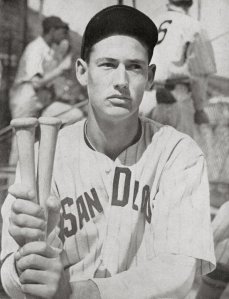
If you follow me on twitter and/or read this blog or 90 Feet of Perfection, you quickly pick up on the fact that I’m a big fan of Ted Williams and the PCL Padres. As a kid, ever since I got my hands on THIS 1992 Upper Deck card, which features the Splendid Splinter in his Padres jersey, I’ve been infatuated with the guy. I had heard about the “original” Padres from family members, but really knew nothing about the history of the team; let alone the fact that the greatest hitter of all time started his professional career with them. Add the fact that shortly after this, Ted Williams took to mentoring Tony Gwynn, and I was forever a fan.
I don’t know much else to say about Williams that hasn’t been said before, especially by myself, but I will repeat my favorite fun fact about him: Ted Williams wore #19 in San Diego, just like Tony Gwynn did over 45 years later. For some reason, I think that’s so cool and uncanny, due to the connection and similarities between both players.
Ted Williams played for the Padres from 1936 to 1937 and was elected to the Hall of Fame in 1966, along with Manager Casey Stengel via the Veterans Committee. Ted’s Hall of Fame speech in one of the more memorable speeches in the game’s history due to the fact that he acknowledged and called for the induction of Negro League players into the Hall of Fame as well. This is obviously incredible and admirable on so many levels, but along with this, even though it has no social implications, I love the fact that he also mentioned Frank Shellenback in his speech. Who is Frank Shellenback you may ask? Well, he was the first manager of the Pacific Coast League Padres, and Ted’s first manager in professional baseball. (Image Source: San Diego Union-Tribune)
Dave Winfield

It can be argued that Dave Winfield was the MLB Padres first legitimate star. Yes, both Randy Jones and Winfield joined the team the same season, but it was the slugger from Minnesota who bloomed first. Some people outside of San Diego may have a hard time associating Winfield with the Padres due to the fact that he played with various teams, but here are a few refreshers regarding his connection to the Friars:
- He played in San Diego for 8 seasons (1973 to 1980) and was an All-Star for four of those seasons.
- He was elected to the team Hall of Fame in 2000.
- In 2001, his #31 jersey was retired by the Padres.
- In 2001, he was elected to the Hall of Fame along with Bill Mazeroski, Kirby Puckett and Hilton Smith. In a somewhat controversial move, Winfield choose to wear his Padres cap on his plaque, making him the first Padre to do so.
- From 2001 to 2013, he worked as the executive vice president/senior advisor (whatever that means) for the Padres, before moving on to work with the Major League Baseball Players Association.
What I’m saying is that Dave Winfield is a Padre. Hell, you still see him wearing his Padres cap during the All-Star celebrity softball games. Also, according to Wikipedia (so take it with a grain of salt), this is taking place during the 2016 All-Star Game:
“The 2016 Major League Baseball All-Star Game, played at Petco Park in San Diego, is expected to be dedicated to Winfield. He had represented the Padres at the first All-Star Game to be played in San Diego.”
Who knows if this is true, but if so, I have no problem with it, as long as other notable Padres from the past get their respect as well. We don’t want another Tony Gwynn debacle to go down. I doubt this will happen, due to the game being held in San Diego…but then again this is MLB and current ownership we’re talking, both which are tone deaf at times. (Image Source: 30-Year Cardboard)
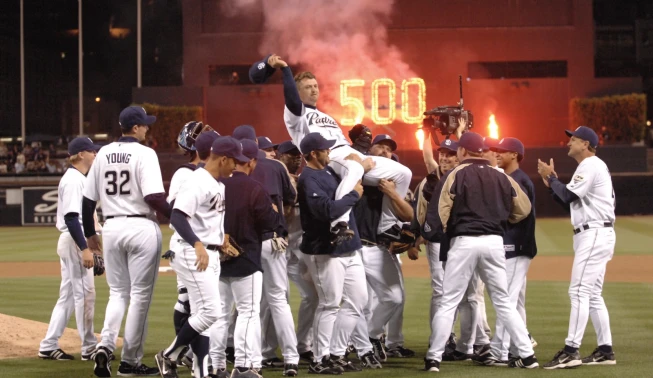 On January 24th, Trevor Hoffman finally got elected into the Hall of Fame, so of course, I had to open this post with a photo related to him. There’s not a lot that I can offer about the Padres longtime closer that’s not currently being said about him, but I wanted to offer my own little congrats to my favorite relief pitcher of all time and offer a few thoughts:
On January 24th, Trevor Hoffman finally got elected into the Hall of Fame, so of course, I had to open this post with a photo related to him. There’s not a lot that I can offer about the Padres longtime closer that’s not currently being said about him, but I wanted to offer my own little congrats to my favorite relief pitcher of all time and offer a few thoughts: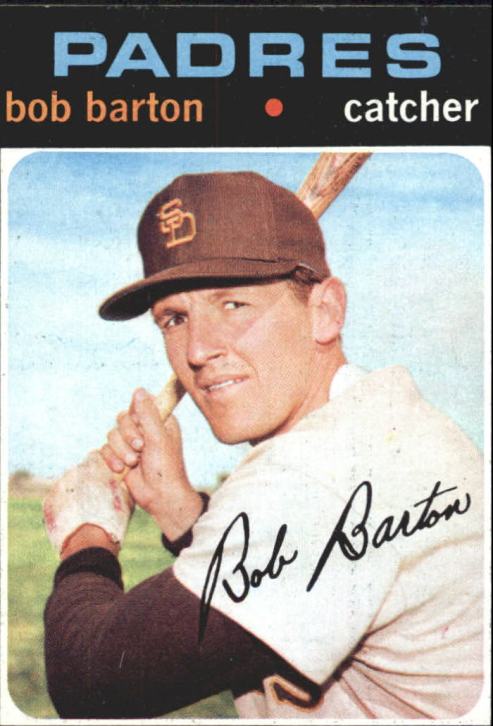
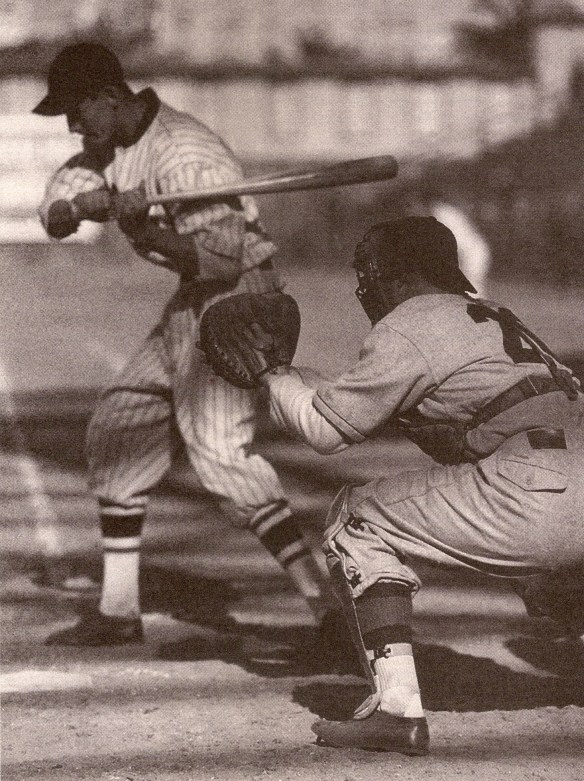 Photos of Ted Williams with the Padres are hard to come by and the ones that do exist are usually just him posing for cameras. This photo of the Splendid Splinter taking a pitch is easily my favorite photo of him in the Pacific Coast League. A decent quality photo of in-game action from the 1930s?? This is the stuff gets my nerdy baseball juices flowing!
Photos of Ted Williams with the Padres are hard to come by and the ones that do exist are usually just him posing for cameras. This photo of the Splendid Splinter taking a pitch is easily my favorite photo of him in the Pacific Coast League. A decent quality photo of in-game action from the 1930s?? This is the stuff gets my nerdy baseball juices flowing!



